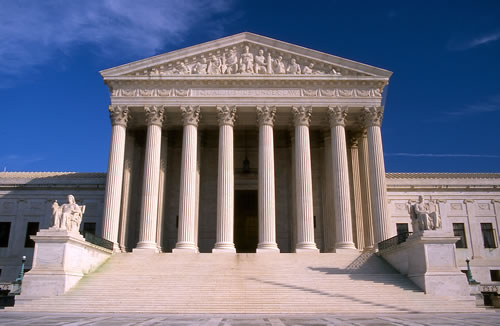

Share
If there ever is a year that proves the importance of judges’ rulings to workers’ rights, 2014 is it. That’s because the jurists in black robes spent much of the year taking rights away.
From the U.S. Supreme Court down to the Los Angeles Superior Court, judges issued rulings that stripped workers of what they had won over the years through collective bargaining, lobbying, or both.
And those two courts’ rulings are actually part of a larger Right Wing campaign to destroy workers’ rights by killing or crippling unions – something the judges involved didn’t say.
The High Court opened the door to thousands of “free riders,” and possibly tens of thousands of union defections, in its Harris vs. Quinn decision. There the justices said that home health care providers paid by the state, whose salaries and benefits were set by the state and whose contract was negotiated by the state with the union a majority of the providers selected, were not really public workers.
That’s because the providers actually worked for a second “employer” – the elderly or disabled individuals they care for. Because of that, they’re only “partially public” workers, Supreme Court Justice Samuel Alito wrote for the 5-man GOP-nominated court majority, and thus “free rider” workers who didn’t want to join the union, but who still get benefits of its contract and its protection in their grievances, didn’t have to pay one red cent for the services.
Alito’s ruling prompted Justice Elena Kagan, leading the dissenters, to forecast a mass exodus, on economic grounds, of workers from public employee unions. Why, she reasoned, should they pay for union services when, under Alito’s dictum, they can get them for free?
In Los Angeles, teachers’ tenure, at least in California, fell victim to Superior Court Judge Rolf Treu. He ruled the state’s teacher tenure laws violated the California constitution’s requirement of equal protection of the law – in this case the law mandating a quality education to all students.
The case was ostensibly brought by a small group of middle-school students who said the tenure laws saddled them with incompetent and unqualified teachers and violated their rights. But if was funded by Right Wing anti-union lawyers and groups. Treu sided with the Right Wingers. Their allies promptly launched a second such case, in New York, and a ballot initiative in Missouri.
Treu’s ruling “stoops to pitting students against their teachers. The other side wanted a headline that reads: ‘Students win, teachers lose.’ This is a sad day for public education,” said AFT President Randi Weingarten. Treu is right that poor and minority students often fall behind others, added Weingarten, a New York City teacher whose union represents mostly teachers and staff in major cities. But Treu’s ruling didn’t explain why, she added.
Treu “argues, as we do, that no one should tolerate bad teachers in the classroom. He is right on that. In focusing on these teachers who make up a fraction of the workforce, he strips the hundreds of thousands of teachers who are doing a good job of any right to a voice.”
The two decisions were among a raft of key rulings on workers’ rights. Others included:
• Whistleblower protection. The justices ruled 9-0 in late June that a public worker cannot be fired for whistleblowing by testifying – truthfully – about fraud before a grand jury and in a trial. In Lane vs. Franks, an Alabama community college president had fired the whistleblower, Edward Lane. The National Education Association helped Lane’s case. The High Court backed Lane, but said employers still retained some residual rights to fire whistleblowers in order to maintain discipline and order in the workplace.
• NLRB hamstrung? The justices ruled that Democratic President Barack Obama exceeded his powers when made three “recess appointments” to the NLRB in 2012. The Senate was in pro-forma sessions at the time – one senator would come in every three days, gavel a session to order and then adjourn it, usually within seconds – to prevent Obama from naming appointees to key jobs in the interim. The justices said the Senate was right, not Obama. That left 120 NLRB cases where the “recess appointees” voted up for grabs. Left unsaid by the justices: Obama had to make the recess appointments because Senate Republican filibusters had blocked all his regular NLRB nominees, as the GOP wants to bring the NLRB – and labor law enforcement – to a dead halt.
• How close can a picket, or a unionist campaigning for a recognition vote, get? That question came up during arguments over a Supreme Court case involving a 35-foot “buffer zone” Massachusetts erected around reproductive rights clinics, to keep pro-lifers from interfering – or harassing – clinic customers. Unions filed friend-of-the-court briefs siding with the pro-lifers. They argued the Massachusetts law was so broad that it would stop union pickets, or campaigners for recognition votes, from even contacting workers outside worksites.
The justices agreed the Massachusetts buffer zone was too wide, and threw it out.
• ESOP trustees must be prudent – and held responsible – when they invest workers’ money in company stock. That’s what the Supreme Court ruled in late June in Fifth Third Bancorp vs. Dudenhoeffer. The Labor Department went to bat for workers in the ESOPs. Until the ruling, DOL said, ESOP trustees could act under a presumption that investing in their own firm’s stock was OK, regardless of the risks involved. But Fifth Third invested workers’ ESOP money in its own stock even though the trustees knew the bank had millions of dollars tied up in subprime mortgages. When they collapsed, so did the stock, and so did the ESOP’s assets.

